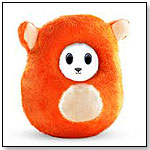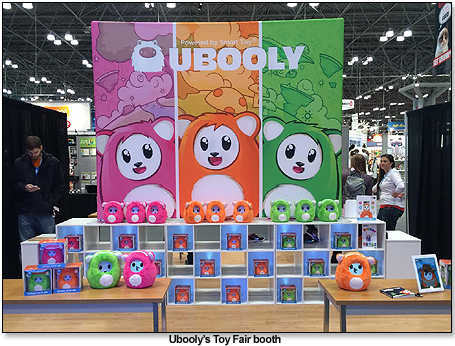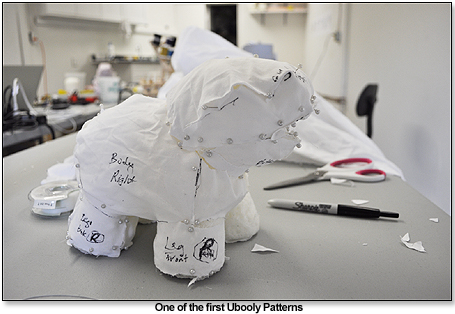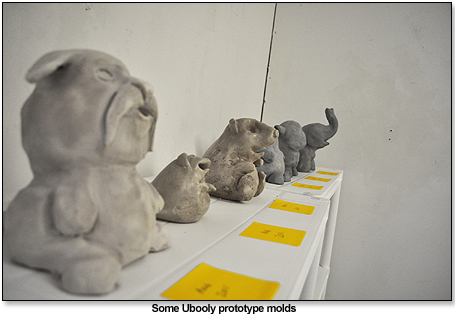
December 16, 2025

November 2014 | Vol. XIII - No. 11
Interview with Carly Gloge, CEO of Ubooly
Ubooly was just acquired by Cartwheel Kids, but before it achieved success in the marketplace, it was just an idea. TDmonthly Magazine talked to Carly Gloge, CEO of Ubooly, to find out how Ubooly was born, and about the challenges and rewards of bringing the product to market.
Q. How did you come up with the idea for your first product?
A. My husband, Isaac and I were working on several mobile games (some for kids), and were curious to see if any of the new advances in technology had made their ways to toys. We wandered through the toy isle, mind-blown that toys hadn't really evolved since our childhood. We had no intention of being toy designers, but after we couldn't find what we were looking for, we decided to build it.
Q. How long did it take to go from the original spark of an idea to actual production?
A. We sat on the idea for a few months since I had hesitations around building hardware, but the idea kept coming up in discussions, so we decided to take a leap of faith, and rented the cheapest workshop we could buy, took sewing lessons, and learned how to make silicone molds. 4 months later, we launched on Kickstarter, and within a year, we completed our first production run.
Q. What were the top two or three most significant obstacles you had to overcome to get your product on the market and how did you do it?
A. Capital and distribution were our most difficult challenges. It's very easy to stay lean as a software company, but hardware takes a significant amount of cash. Kickstarter not only gave us initial funding, but also proved to angel investors and venture capitalists that there was demand. Distribution is a challenge for a young company as well. Many retailers would prefer to stick to safe bets with existing vendors. We focused on driving our own direct sales through online advertising, and direct response TV advertising. Retailers like Bloomingdales, AT&T, and Apple have now come around to sell the product.
Q. How did you decide on how much money you needed to raise with your initial Kickstarter campaign?
A. Honestly, we raised the bare minimum. It wasn't enough to cover all of our costs, but Kickstarter was very new, so we wanted to be realistic. $25k seemed achievable, but a high enough bar to prove demand.
Q. What were the biggest challenges you had using Kickstarter?
A. The pressure to ship on time can be tough. We really wanted to meet our timelines, but we probably should have shipped a month late to avoid a lot of unnecessary additional costs that came with rushing.
Q. If you had to do it all again, would you still look to a crowdfunding site to help raise your initial funds? If so, why?
A. Definitely! Having an audience of engaged backers are amazing. Our Kickstarter backers still help us out by testing new content before we release it, and submitting new story ideas. If I did it again, I would just focus on engaging them with even more updates since I hadn't originally realized how involved they wanted to be.
Q. What aspect of the toy industry most surprised you when you first started?
A. It was a lot more intimidating than I expected it to be. The tech startup world tends to be a little less guarded so I often felt as if I wasn't following protocol at some of the toy industry events by being so informal.
Q. How do you hope your product/s will affect children's lives?
A. I'm very passionate about building toys that kids will create a long-term emotional attachment to. I want the kids who play with our toys to grow up with nostalgic memories of every product we make.
Q. If you had to start over, what would you do differently?
A. I would have tried harder to manufacture locally for our first production run even if we didn't make money on the products. This would have lowered our minimum order size, and allowed us to adapt the product more rapidly.
Q. What were the top two or three best pieces of advice you received on bringing your product to market, and from whom?
A. Dan Shapiro, the creator Robot Turtles helped teach me that customers really care about hearing your story, and why you're building your product.
Mark Schuster, one of our advisors told me advised me to wait on hiring sales staff before going out and selling myself. Meeting with buyers directors directly allowed me to learn more about how to demo our product, and how retailers evaluate new product lines.
Q. The worst two or three pieces of advice?
A. A lot of our mentors believed in the software mantra of rapidly releasing products and iterating. Many though this could translate to hardware too. Even changing something as simple as packaging dimensions created a ton of headache with our warehouse, Amazon, etc. We still push regular software updates to the toy, but we're much more careful on iteration on the physical product.
Q. What one unique quality makes your product better than your competition?
A. Our real edge comes from our ability to update Ubooly's content realtime. We carefully review our statistics on how kids are engaging with activities, and adapt the product. This means that our customers get a product that will be even better down the road. It's gone a long ways in building an evangelistic community that share's Ubooly with their network.
Q. What advice would you give to aspiring toy and game designers and inventors?
A. Ideas are great, but it's all about putting in the hours to really bring a product to life. I've met a lot of folks that are really passionate about their ideas, but never fully commit to them. It takes sacrifice, but it's all worth it at the end of the day.
Ubooly by UBOOLY INC
 Ubooly is a stuffed animal powered by an iPhone or iPod touch. Put the device in its fuzzy pocket, and Ubooly comes to life. Includes the Ubooly stuffed animal, the Ubooly software, and free monthly content updates. 2/26/2013 (MSRP: $29.99)
Ubooly is a stuffed animal powered by an iPhone or iPod touch. Put the device in its fuzzy pocket, and Ubooly comes to life. Includes the Ubooly stuffed animal, the Ubooly software, and free monthly content updates. 2/26/2013 (MSRP: $29.99)
Copyright © 2025 TDmonthly®, a division of TOYDIRECTORY.com®,
Inc.






 Ubooly is a stuffed animal powered by an iPhone or iPod touch. Put the device in its fuzzy pocket, and Ubooly comes to life. Includes the Ubooly stuffed animal, the Ubooly software, and free monthly content updates. 2/26/2013 (MSRP: $29.99)
Ubooly is a stuffed animal powered by an iPhone or iPod touch. Put the device in its fuzzy pocket, and Ubooly comes to life. Includes the Ubooly stuffed animal, the Ubooly software, and free monthly content updates. 2/26/2013 (MSRP: $29.99)